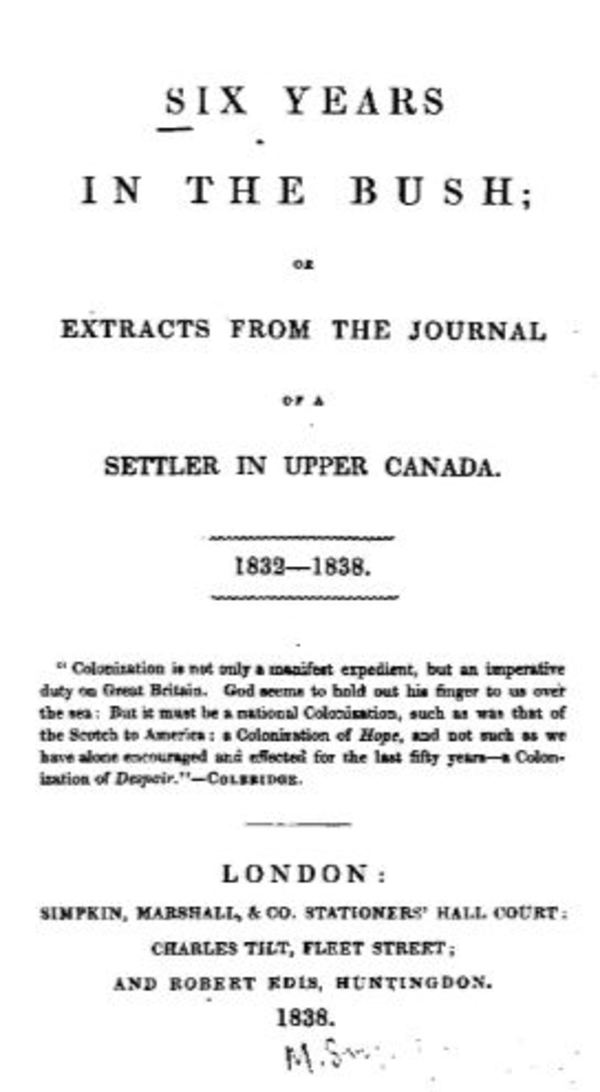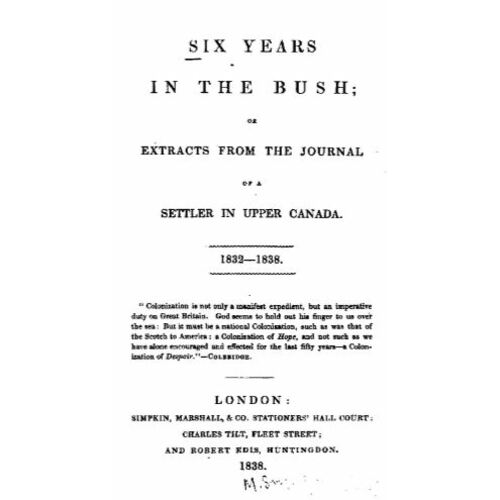
Source: Link
NEED, THOMAS, businessman, office holder, jp, militia officer, journalist, and author; b. 14 March 1808 in Mansfield Woodhouse, England, third son of John Need and Mary Welfitt; m. 23 May 1850 Elizabeth Anne Godfrey in Balderton, Nottinghamshire, and they had one daughter; d. 8 March 1895 in Nottingham.
Thomas Need enjoyed a comfortable childhood in an area where his family traced its origins to the early 16th century. His father was a country landowner and local magistrate. Thomas’s formal education followed family tradition: at age 11 he entered Rugby School and by 1830 had earned a ba at University College, Oxford. But neither the military and commercial traditions of the Needs nor the Church of England affiliation of the Welfitts attracted Need. Like other gentlemen in a similar position, he chose immigration to Upper Canada. He arrived at York (Toronto) in late May 1832 and settled in Verulam Township, near Peterborough, the following April.
The combination of modest capital and capability guaranteed Need a significant role in this pioneer region. He formed a partnership to invest in land with George Strange Boulton*, a lawyer and politician from Cobourg. Need was an important member of the government commission which supervised the building of the first lock on the Trent water-way, at what became Bobcaygeon, in 1833–34. In 1834 he founded the village and established beside the lock the hallmarks of any pioneer community – sawmill, gristmill, and general store. In 1835 he was appointed local magistrate of the Court of Requests and was reappointed two years later. He became Verulam’s first clerk in January 1836. In 1841 he represented the area in the newly formed Colborne District, but increasing deafness precluded his continuing. He also volunteered for militia duty as a lieutenant and, between 1838 and 1842, he was occasionally a correspondent about local affairs for the Cobourg Star.
When water was diverted from his sawmill in 1837 to repair the canal, Need returned to England for a visit. Prompted by the interest in his Canadian experiences and the appeal of exotic travel narratives, Need prepared, with the assistance of an Oxford friend, a book based on his diary. Because he intended the book to combine autobiography with occasional touches of fantasy, he decided to publish it anonymously and not to give it the title of his wholly factual diary, called “Woodhouse” after his childhood home in England and his log abode in Upper Canada. Six years in the bush (1838) is a brief and enthusiastic glimpse of an educated man’s successful adjustment to the wilderness. Written in an economical style, the book balances frequent observations of Need’s first years in Upper Canada with fewer entries in later years, when his responsibilities increased. The book was initially advertised as a sequel to The backwoods of Canada (1836) by Catharine Parr Traill [Strickland], and, even though it was one of many that had been written about the pioneering experience, it received respectable coverage in British periodicals. One review observed that “this plain volume is one of the most valuable of its kind that we have seen”; another found “the day-by-day account of his employments and amusements . . . very interesting, partly in itself and partly from the character of the writer.” The book naturally aroused curiosity among Need’s cultured near neighbours in Upper Canada, including John and Anne Langton. Anne was not concerned about its “deviations from the undeniable” but she felt it was “a slight affair to have attracted so much notice, as from its mention in the periodicals.” Although it was among the earliest works written by the Sturgeon Lake group, fuller accounts of backwoods life by other immigrants, including Frances Stewart [Browne*], Susanna Moodie [Strickland*], and Samuel Strickland*, would eclipse Need’s concise book.
Need returned to Upper Canada in the autumn of 1838, bearing copies of the book for his friends (he made no secret of its authorship among his backwoods circle). Perhaps exhilarated by its reception, he began a collection of essays on life and people in his settlement, but Six years remained his only publication. An inheritance from a maternal aunt in 1843, along with the slow advancement of the Sturgeon Lake area, persuaded Need to return to England, which he did permanently in 1847. His investments in Upper Canada were administered or purchased by other gentlemen pioneers – Mossom Boyd, John Langton, and Robert and James Frederick Dennistoun. After his marriage Need led a fashionable, urban life in Nottingham, but also enjoyed fox hunting and annual shooting expeditions to Scotland. Always scholarly by nature, he turned to literature and poetry with advancing years and deafness. For no apparent reason he made a last visit to Ontario in the summer of 1884.
Need’s decision to publish Six years anonymously, the dispersal of his circle of friends in Upper Canada, and his own return to England were factors in his being denied his place in the history of Canadian literature for nearly a century. A bibliography published in 1895 attributed the book to Susanna Moodie. William Renwick Riddell*’s researches some two decades later uncovered Need’s identity but Riddell chose to respect his anonymity. It was not until John Langton’s letters were published, in 1926, that Thomas Need’s authorship and contribution to Canadian literature were revealed.
Thomas Need is the author of Six years in the bush; or, extracts from the journal of a settler in Upper Canada, 1832–1838 (London, 1838; repr. Bobcaygeon, Ont., [1981]).
AO, MU 2186; RG 22, ser.387, box 1, file 1836(1), Verulam Township minutes, 8 Jan. 1836. NA, RG 43, CII, 1, 2434: 216–17; RG 68, General index, 1651–1841: 490, 503. Gentleman’s Magazine (London), July–December 1850: 201. Anne Langton, A gentlewoman in Upper Canada; the journals of Anne Langton, ed. H. H. Langton (Toronto, 1950; repr. 1967). John Langton, Early days in Upper Canada: letters of John Langton from the backwoods of Upper Canada and the Audit Office of the Province of Canada, ed. W. A. Langton (Toronto, 1926). T. W. Poole, A sketch of the early settlement and subsequent progress of the town of Peterborough . . . (Peterborough, Ont., 1867; repr. 1967). Spectator (London), 16 June 1838: 572; 30 June 1838: 614. Tait’s Edinburgh Magazine, new ser., 5 (1838): 535–38. The valley of the Trent, ed. and intro. E. C. Guillet (Toronto, 1957). Cobourg Star (Cobourg, [Ont.]), 26 Sept. 1838; 23 Feb., 20 July 1842. Mansfield and North Notts Advertiser (Mansfield, Eng.), 15 March 1895. Alumni oxonienses; the members of the University of Oxford, 1715–1886 . . . , comp. Joseph Foster (4v., Oxford and London, 1888). Burke’s landed gentry (1900); (1937). Philéas Gagnon, Essai de bibliographie canadienne . . . (2v., Québec et Montréal, 1895–1913; réimpr. Dubuque, Iowa, [1962]), 1: 465. M. L. Walker, A history of the family of Need of Arnold, Nottinghamshire (London, 1963). M. L. Evans, “Preliminary history of Bobcaygeon Lock Station” (mimeograph, Parks Can., Ontario Region, Trent-Severn Waterway Interpretive Program, Pub., 006, [Cornwall, Ont., 1983]). G. H. Needler, Otonabee pioneers: the story of the Stewarts, the Stricklands, the Traills and the Moodies (Toronto, 1953). W. R. Riddell, “How Englishmen once came to Toronto,” Canadian Magazine, 59 (May–October 1922): 274–76.
Cite This Article
Dawn Logan, “NEED, THOMAS,” in Dictionary of Canadian Biography, vol. 12, University of Toronto/Université Laval, 2003–, accessed December 17, 2025, https://www.biographi.ca/en/bio/need_thomas_12E.html.
The citation above shows the format for footnotes and endnotes according to the Chicago manual of style (16th edition). Information to be used in other citation formats:
| Permalink: | https://www.biographi.ca/en/bio/need_thomas_12E.html |
| Author of Article: | Dawn Logan |
| Title of Article: | NEED, THOMAS |
| Publication Name: | Dictionary of Canadian Biography, vol. 12 |
| Publisher: | University of Toronto/Université Laval |
| Year of publication: | 1990 |
| Year of revision: | 1990 |
| Access Date: | December 17, 2025 |



